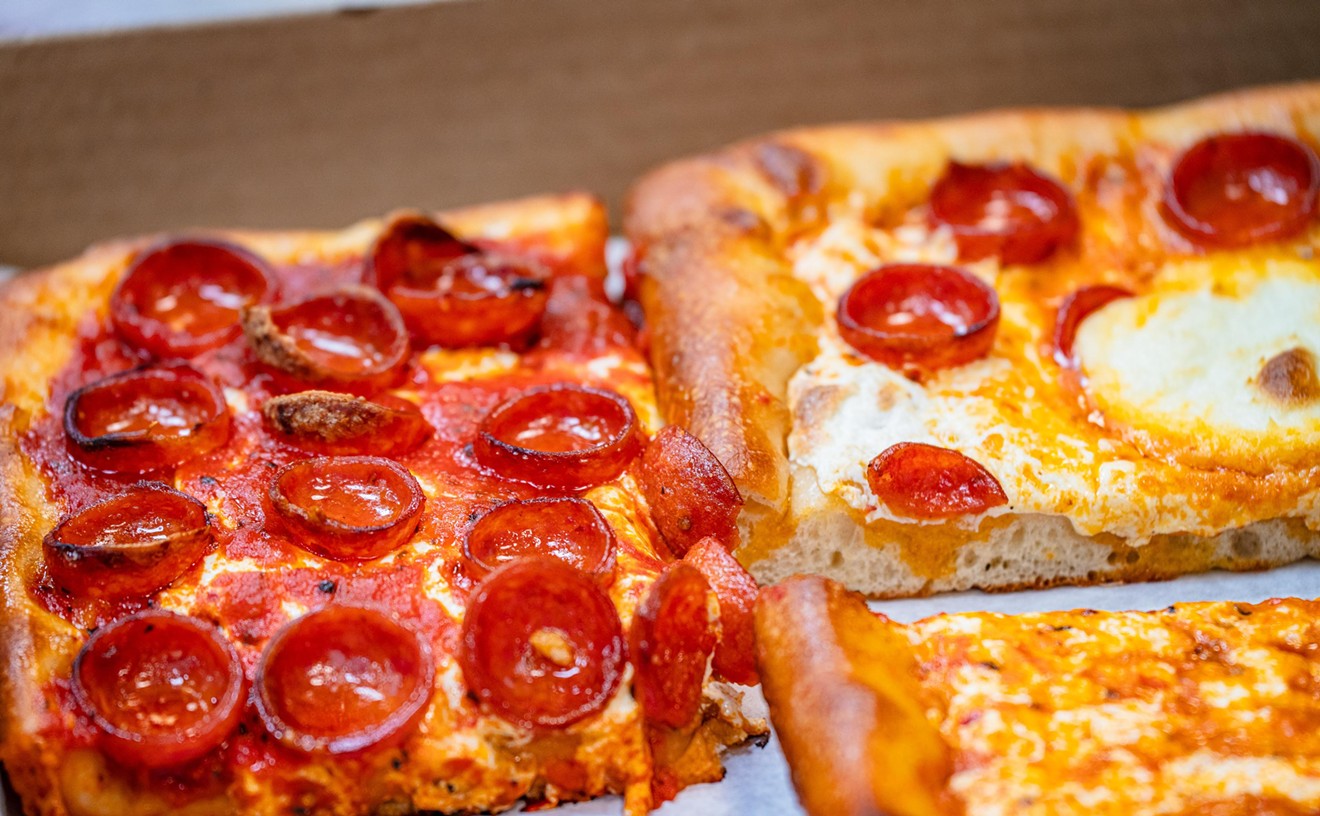When chef-proprietor Murray and his New York City partners first arrived here in 1992 to open their restaurant BANG -- an outgrowth of BOOM, their place in New York -- South Beach was in the full throes of wanton adolescence. Murray's Asian-influenced fare was over-the-top and delicious, and so were his patrons: club kids climbing on tables to flash some booty or bare a breast between courses. BANG quickly became a stop on the social circuit, along with places such as the Colony Bistro, which featured chef Robbin Haas, and the Raleigh Hotel's first venture, chef Kerry Simon's Blue Star. The names of Murray, Haas, and Simon began to pop up in local gossip columns as often as those of various supermodels.
But restaurants with celebrity status face a two-fold problem. One: Serious diners can become alienated by the clientele's antics and the attendant media buzz. Two: A hip-to-the-moment place must constantly reinvent itself or risk boring the bar-crowd audience on which its survival depends.
BANG went into a decline when its trendiness wore off and it didn't have the support of a core of regulars. When Murray went back to BOOM in 1995, BANG attempted to recharge itself: Haas was hired to replace Murray, at which point the Colony Bistro lost its energy. But the arrangement didn't last long. Haas left the area the following year to work with friend and superchef Mark Miller on projects in San Francisco and Washington, D.C. The BANG site was eventually sold and now operates under different owners as Abracadabra at BANG.
Flash-forward to 1998. Kerry Simon is nowhere in sight. He departed South Beach after his third venture -- Max's South Beach, which morphed into the mercurial Mercury -- failed. (His stint at Blue Star lasted about six months; from there he moved on to spend less than a year at the innovative seafood restaurant Starfish, which now operates as a club.) But Haas is back in town, this time heading up Red Square, a restaurant managed by the China Grill team. And Murray, after consulting with his partners on additional BANG and BOOM restaurants in Mexico City and Madrid, is now working in Simon's first haunt -- the kitchen of the Raleigh Hotel.
"I'd planned to come down here and write," notes Murray, who'd been touring what he terms "the spice markets of the world" while researching his forthcoming cookbook The Global Table, scheduled to be published by Random House sometime next year. Then he ran into Kenny Zarilli, owner of the Raleigh, whose chef Marc Lippman had recently left for New York. "It's funny," Murray adds. "We'd originally wanted to lease out the dining room at the Raleigh for BANG, but it wasn't ready yet. I wasn't going to take the job this time, but Kenny told me, 'You're a workaholic. You can't not work.' And he's right. So here I am."
Murray may be unable to kick his work addiction, but he has made strides regarding self-restraint: His cuisine isn't as showy these days. It cajoles the diners rather than confronts them. And this new conservative style -- "I don't go too out-there," he confesses -- fits right in with the grown-up South Beach that features other sophisticated hotel restaurants, such as Twelve Twenty in the Tides, Blue Door at the Delano, and the Oval Room at the National Hotel. At the six-month-old Tiger Oak Room, the only flashbulbs popping are those of tourists documenting their vacations. No nubile youngsters cavorting on tabletops here. Just candelabra giving off light that dances on white linen. On the night I visited, fresh lilies were the only things showing off their cheeky bloom in this romantic, 75-seat dining room with its terrazzo floor, warm wood accents, and floor-to-ceiling windows that overlook a serene pool. Well, okay, there were some skimpily dressed diners but at least they kept their clothes on.
Patrons looking for a remnant of the old BANG must make do with the menu, which offers several familiar appetizers. I used to love BANG's Vietnamese five-spice grilled quail and, it turns out, I still do. The dark-meat quail, supple and moist, featured an almost candied skin that was only a little too salty. Half a bird lay on a red cabbage slaw that had been marinated with fresh mint and nuoc cham (Vietnamese dipping sauce). Another Asian starter, the Japanese-style seaweed salad, was simply excellent. The fresh spinach leaves were as tender as a young girl's eyes when gazing at Leonardo DiCaprio. Looped around the spinach were marinated seaweed strands, which tasted largely of sesame oil and looked more like glass noodles than vegetable matter; the noodles provided a superb contrast to the greens, which had been coated with a mellow carrot-ginger vinaigrette.
Poached oysters were a wonderful way to prepare the palate for other delicacies, though the $15 price tag might turn the stomach a little. Served at room temperature, the five oysters were lightly poached, enough to remove the sliminess associated with the raw shellfish but still leave intact their tantalizing sea essence. After being poached, the oysters were returned to their shells, placed atop a shredded leek compote mixed with a potato cream sauce (freshly grated potato starch simmered with cream and buttermilk). A dab of black caviar glistened on the oysters, livening up the soft, buttery textures.
The menu seems a bit limited: ten first courses, nine entrees. The main courses do cover a wide range, however, including a choice for vegetarians. "It's not nice to punish people who want to eat just vegetables," Murray explains, "so I try to make even the plainest dishes interesting." Thus his Moroccan vegetable couscous was spiced to entice. Chunks of carrot, turnip, fennel, zucchini, and tomato were slow-cooked with cumin, cinnamon, turmeric, coriander, cilantro, and parsley. Murray even adds a bit of blue cheese to the dish's sauce, which lends it an authentically sour taste -- achieved in Morocco with fermented yogurt (unavailable in the United States). The vegetable stew was served separate from the couscous, so you could spoon as much as you like over the grain.
With the exception of the couscous, the entrees tend to be small in size. Seared sea scallops with seafood dumplings were especially unsatisfying given that the four scallops, though beautifully cooked, were oddly bitter. The dumplings improved our opinion of the dish. The minced seafood, steaming inside their doughy shells, soaked up the scallops' masterful herb-green Thai curry broth. Monkfish was a slightly bigger potion. The thick, flaky fillet was covered with an oven-dried, tomato/black olive mixture, hearty and immensely flavorful. A scoop of mashed potatoes, flecked with basil, propped up the roasted fish.
A filet mignon rivaled the monkfish for vibrancy. Murray labels this dish a staple, meaning that it will remain on the menu, which he changes every six weeks or so. The succulent beef was topped with broiled blue cheese and bottomed by crisp triangles of hash browns. Piles of caramelized onions gleamed on the edges of the plate like galleon gold.
Delicate portions left us plenty of room for dessert, notably the warm Venezuelan chocolate cake covered with chocolate sauce, composed by pastry chef James Thegenus. As one of my guests gushed, "Damn, that's a good brownie." Don't expect to enjoy a glass of port with your sweet, though. We asked our waiter to recommend one, at which point he disappeared to the bar. Returning, he said, "Well, we've got Grand Marnier."
Service in general could use some improvement. The waiter didn't know the menu, and water and bread refills were as difficult to come by as free parking. The Raleigh charges ten bucks to put your car in its lot, located about ten feet from the valet stand. Given the ridiculous distance and the fee, we were a little miffed to find that our front seats -- both of them -- had been moved and the radio station changed.
Restaurants such as the Tiger Oak Room prove that the South Beach dining scene has begun to mature. Now if only we can get the valets to do the same.
Tiger Oak Room (in the Raleigh Hotel)
1775 Collins Ave, Miami Beach; 534-1775. Breakfast and lunch daily from 7:00 a.m. to 3:00 p.m.; Saturday and Sunday brunch from 11:30 a.m. to 3:30 p.m. Dinner Wednesday -- Sunday from 7:00 to 11:00 p.m.; Friday and Saturday until midnight.
Spinach salad
$9.00
Vietnamese grilled quail
$9.00
Roasted monkfish
$21.00
Filet mignon
$26.00
Venezuelan chocolate cake
$7.00










